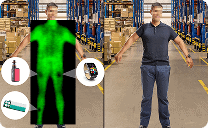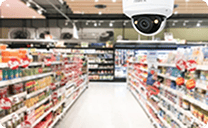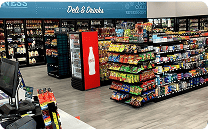In This article
A CCTV camera (Closed-Circuit Television) is a foundational component of modern surveillance systems. Unlike broadcast television, which transmits to the public, CCTV operates on a closed system. Video feeds are sent to a restricted set of monitors, recorders, or storage devices for viewing and analysis. These cameras are critical in deterring crime, monitoring operations, and enhancing security across business, industrial, and public environments.
Originally developed for military and high-security applications, CCTV has evolved into a versatile solution for monitoring everything from retail stores, restaurants, and office buildings to warehouses, manufacturing plants, and transportation hubs.
How CCTV Cameras Work
At its core, a CCTV camera captures video footage. It transmits through a wired or wireless connection to a centralized location, such as a Digital Video Recorder (DVR), Network Video Recorder (NVR), or cloud-based storage platform. From there, footage can be stored, reviewed, or analyzed in real-time or retrospectively.
The basic components of a CCTV system include:
- CCTV Camera: Capture footage in various resolutions and lighting conditions.
- Lenses: Determine the field of view and focal range.
- Cabling or Network Equipment: Transmit the video signal.
- Recording Device (DVR/NVR): Stores and organizes video for retrieval.
- Monitors: Display live or recorded footage for security personnel.
Types of CCTV Cameras
A CCTV camera comes in several forms, each suited for different use cases:
- Dome Cameras: Compact and vandal-resistant, ideal for indoor ceilings and discreet monitoring.
- Bullet Cameras: Long and cylindrical, often used outdoors for long-range viewing.
- PTZ Cameras (Pan-Tilt-Zoom) Offer remote directional control and zoom functionality, allowing operators to monitor large areas actively.
- Turret Cameras: Versatile and adjustable, with clear night vision and less glare than domes.
- 360° or Fisheye Cameras: Provide wide-area coverage from a single point and are often used in open spaces.
- Infrared/Night Vision Cameras: Designed for low-light or complete darkness.
- License Plate Recognition (LPR): Specialized cameras for capturing vehicle license plates.
Analog vs. IP-Based CCTV Systems
Originally, CCTV systems were analog. These systems transmitted video via coaxial cable to a DVR, which digitized and stored the footage. Modern systems, however, are increasingly IP-based (Internet Protocol). These use networked digital cameras that transmit data over Ethernet and store video on NVRs or in the cloud.
- Analog CCTV: Lower cost, but limited resolution and flexibility.
- IP CCTV: Higher resolution, more scalability, and supports remote access and AI analytics.
Many modern CCTV systems incorporate AI-powered analytics, turning passive video streams into intelligent, responsive tools. Examples include:
- Motion Detection: Triggers record or alert when movement is detected.
- Facial Recognition: Identifies individuals using biometric data.
- Object Tracking: Follows specific people, vehicles, or items across multiple cameras.
- Line-Crossing and Intrusion Detection: Defines virtual perimeters and alerts when breached.
These smart functions help reduce false alarms, improve response times, and allow for proactive CCTV cameras to serve a wide range of purposes across sectors:
- Loss Prevention: Monitoring retail floors or stockrooms to deter theft.
- Operational Oversight: Supervising workflow in manufacturing or logistics.
- Access Control: Monitoring entry points and integrating with badge or biometric systems.
- Compliance: Verifying that safety and procedural protocols are being followed.
- Incident Investigation: Reviewing footage to analyze accidents, misconduct, or breaches.
Considerations for Implementation
When selecting a CCTV Camera system, businesses should consider:
- Resolution and Coverage Needs: How much detail is required, and over what area?
- Lighting Conditions: Are cameras needed for night or low-light settings?
- Storage Capacity: How long do you need to retain footage, and where will it be stored?
- Remote Access and Alerts: Do you need mobile viewing or real-time notifications?
- Privacy and Legal Compliance: Ensure system placement and data retention meet local regulations.
Modernize Your CCTV Strategy with DTiQ
CCTV cameras are the backbone of business surveillance—but without the right tools, they’re just silent observers. DTiQ transforms traditional CCTV systems into intelligent video security platforms with real-time monitoring, cloud-based video storage, and advanced analytics. Whether upgrading legacy equipment or deploying cameras across multiple sites, DTiQ helps you gain actionable visibility, reduce loss, and improve performance from the front line to the back office. To learn more about DTiQ’s retail, C-store, and QSR solutions, visit our website.





























